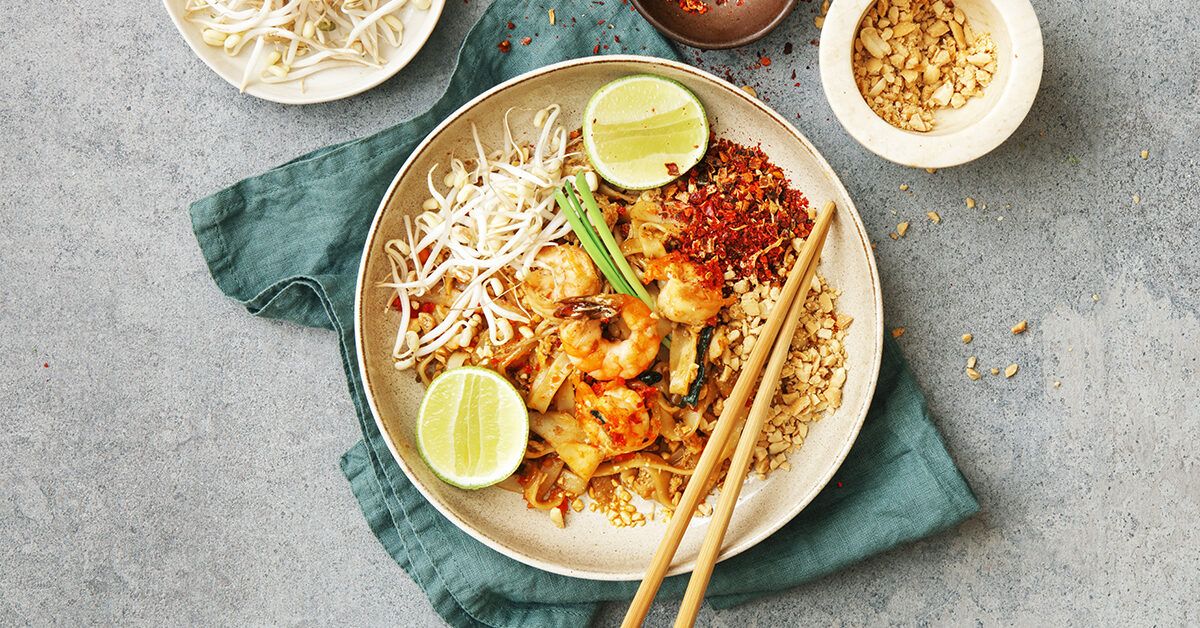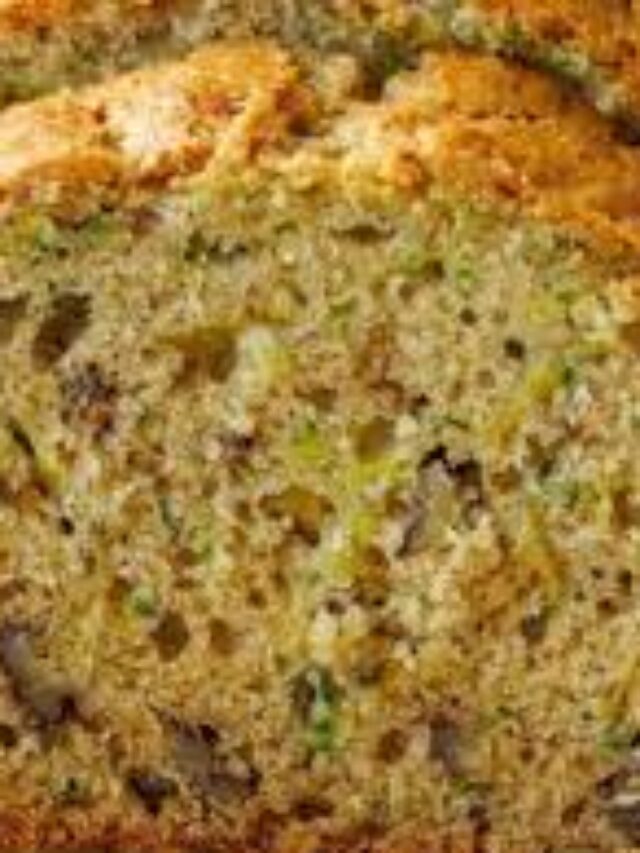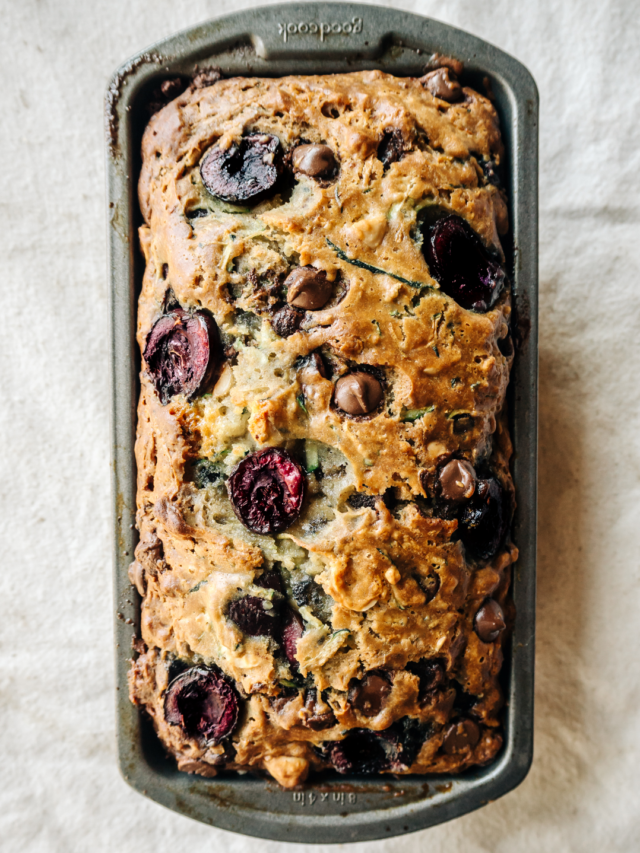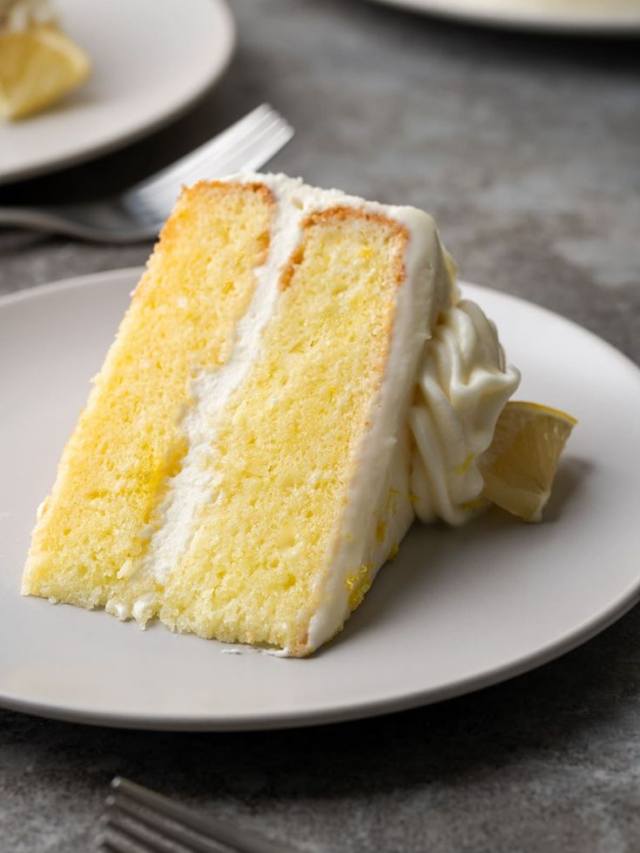The Basics Of Pad Thai
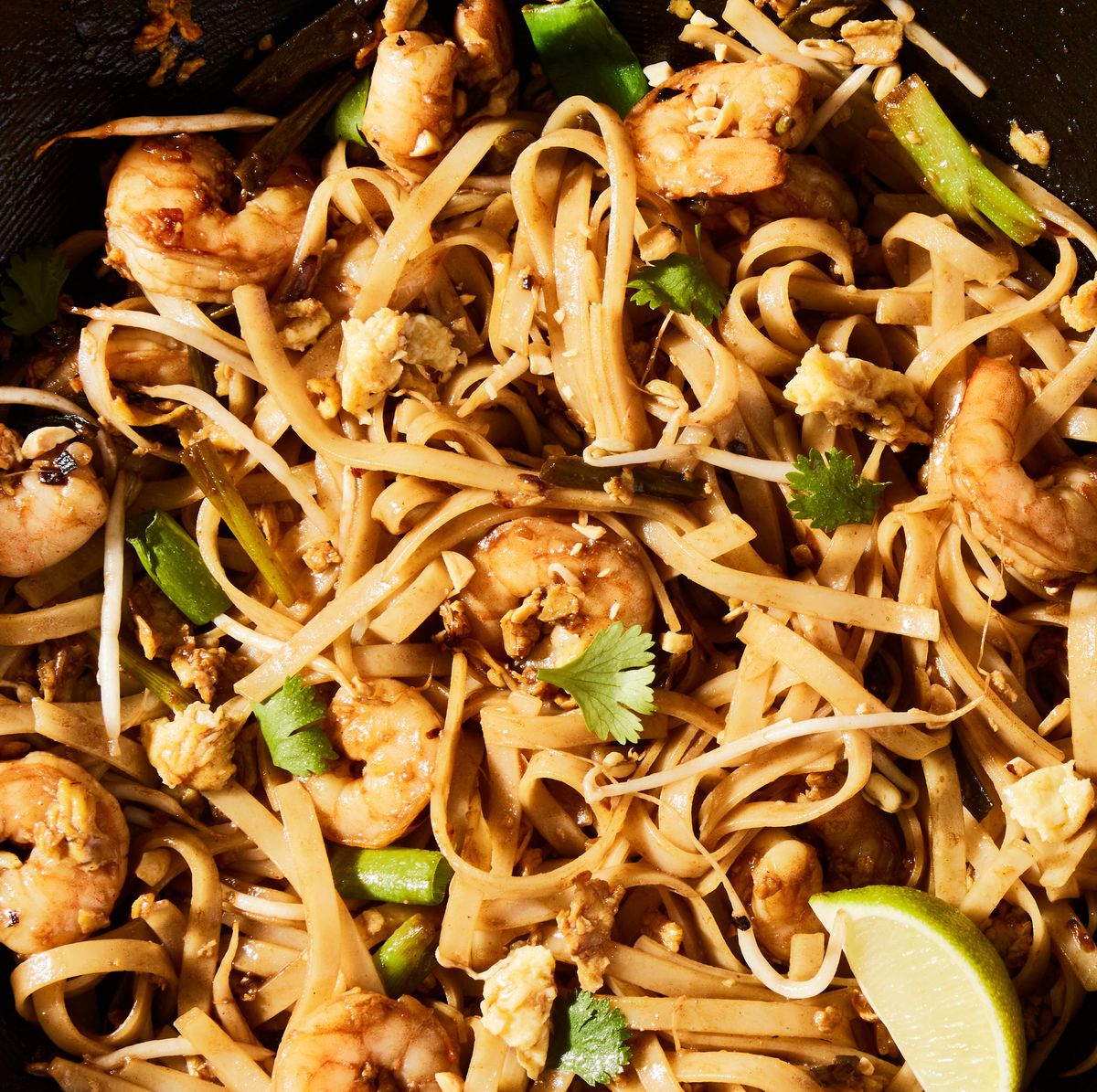
Pad Thai is a popular stir-fry dish that originated in Thailand. It is known for combining rice noodles, protein (such as shrimp, chicken, or tofu), peanuts, scrambled eggs, and fresh vegetables. The dish is cooked quickly in a wok and tossed in a flavorful Pad Thai sauce. With its sweet, tangy, and savoury flavours, Pad Thai is a favourite among Thai cuisine lovers. This easy Pad Thai recipe is perfect for a quick and delicious meal, ready in under 30 minutes. So why not give it a try?
The Origin And History Of Pad Thai
Pad Thai is a beloved dish that has deep roots in Thai cuisine. Its origin can be traced back to the 1930s, during a period known as Thailand’s nationalist movement. The government encouraged the consumption of rice noodles to promote national identity and unity. With its mix of flavours and textures, Pad Thai quickly became a favourite among locals and foreigners. Today, it is enjoyed in Thailand and has gained popularity worldwide. Its rich history and cultural significance make Pad Thai a true culinary gem.
Key Ingredients For Authentic Pad Thai
Authentic Pad Thai is characterized by its unique blend of flavours and textures. Certain key ingredients are essential to recreate this classic dish. Here are the must-have components for an authentic Pad Thai recipe:
- Rice Noodles: Made from rice flour, these thin and flat noodles provide the base for Pad Thai.
- Tamarind Paste: This tangy and slightly sweet paste adds the signature tartness to the dish.
- Fish Sauce: A staple in Thai cuisine, fish sauce lends a savoury umami flavour to Pad Thai.
- Palm Sugar: Used as a sweetener, palm sugar balances out the tartness of tamarind and adds depth to the dish.
- Bean Sprouts: These crunchy sprouts add freshness and textural contrast to the Pad Thai.
- Lime: A squeeze of lime juice enhances the flavors and brightens the dish.
- Peanuts: Crushed peanuts are sprinkled on top for a satisfying crunch.
Using these key ingredients, you can create an authentic and delicious Pad Thai that captures the essence of Thai cuisine.
Simple Steps To Make Pad Thai
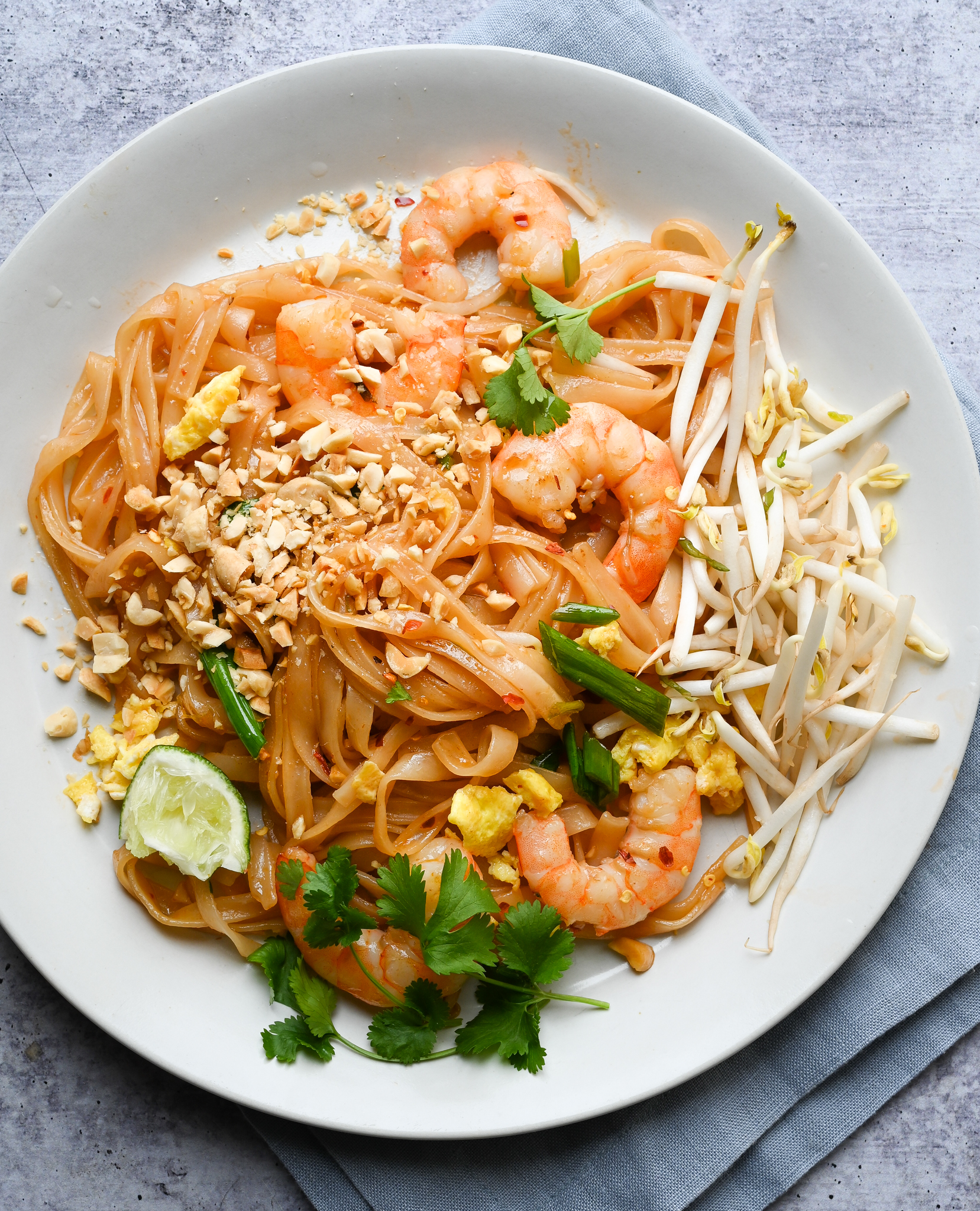
To make Pad Thai at home, follow these simple steps:
- Soak rice noodles in warm water for about 15 minutes until they become soft and pliable. Drain and set aside.
- Heat oil and sauté garlic until fragrant in a hot skillet or wok.
- Add your choice of protein (such as shrimp, chicken, or tofu) and cook until cooked.
- Push the protein to one side and crack an egg into the pan. Scramble the egg until cooked.
- Add the soaked rice noodles to the pan and stir-fry for a few minutes.
- Add the Pad Thai sauce (tamarind paste, fish sauce, and palm sugar) and stir well to coat the noodles.
- Toss in bean sprouts and green onions, stirring for an additional minute.
- Remove from heat and squeeze fresh lime juice over the Pad Thai.
- Garnish with crushed peanuts and serve hot.
Enjoy your homemade Pad Thai with its perfect combination of flavours and textures!
Preparation And Cooking Techniques For Pad Thai
Preparation and Cooking Techniques for Pad Thai:
To make Pad Thai, soak rice noodles in warm water until soft and pliable. Drain and set aside.
In a hot skillet or wok, sauté garlic in oil until fragrant. Add your choice of protein, such as shrimp, chicken, or tofu, and cook until fully cooked.
Push the protein to one side and crack an egg into the pan. Scramble the egg until cooked through.
Next, add the soaked rice noodles to the pan and stir-fry for a few minutes.
Then, add the Pad Thai sauce, a combination of tamarind paste, fish sauce, and palm sugar. Stir well to coat the noodles.
Toss in bean sprouts and green onions, stirring for an additional minute.
Remove from heat and squeeze fresh lime juice over the Pad Thai.
Garnish with crushed peanuts and serve hot.
These techniques ensure your Pad Thai is perfectly cooked, with the flavors melding together beautifully.
Tips For Perfecting Your Pad Thai Recipe
To perfect your Pad Thai recipe, here are some helpful tips:
- Don’t overcook the noodles: Cook the rice noodles until they are soft and pliable. Overcooked noodles can turn mushy and ruin the texture of the dish.
- Use high heat: Stir-frying the ingredients on high heat ensures they cook quickly and retain their crispness.
- Customize the flavours: Adjust the balance of the Pad Thai sauce according to your taste preference. Add more tamarind for tanginess, more fish sauce for saltiness, or more palm sugar for sweetness.
- Add crunch with crushed peanuts: Sprinkle crushed peanuts on top of your Pad Thai for extra texture and flavor.
- Garnish with fresh herbs: Adding fresh cilantro or Thai basil at the end enhances the dish’s aroma and freshness.
- Serve immediately: Pad Thai is best enjoyed when hot and fresh. Serve it immediately after cooking to savour all the flavours.
These tips make a perfect Pad Thai bursting with authentic flavors and textures.
Popular Variations Of Pad Thai
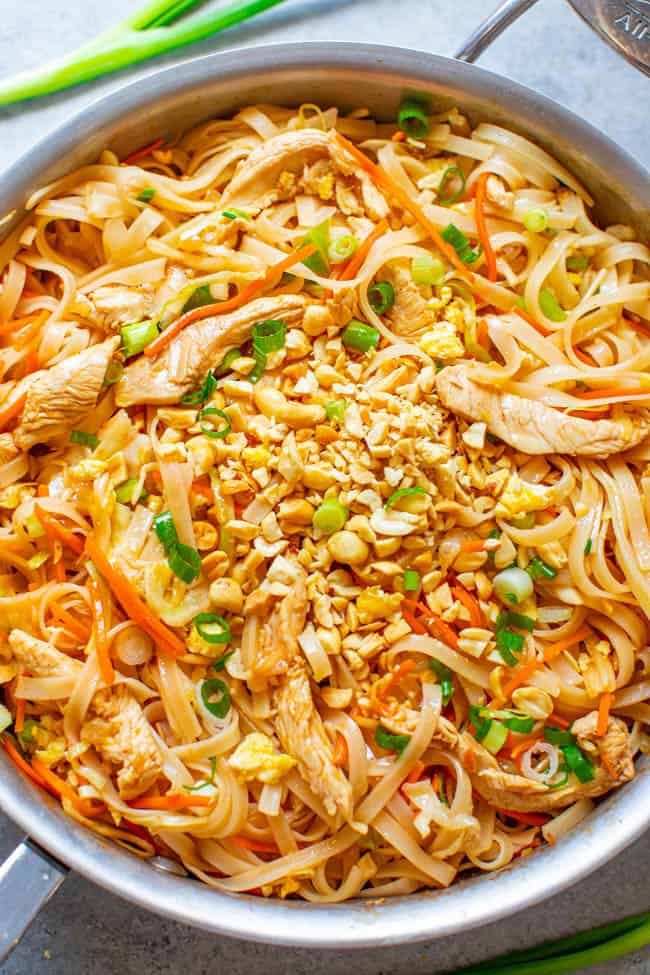
Popular Variations of Pad Thai: Pad Thai is a versatile dish that can be customized to suit different tastes and dietary preferences. Here are some popular variations of Pad Thai:
- Seafood Pad Thai: Instead of chicken or tofu, seafood such as shrimp, squid, or scallops are added to the dish for a delightful seafood twist.
- Vegetarian Pad Thai: Vegetarians can enjoy Pad Thai by omitting the meat and adding more vegetables or using tofu as a protein substitute.
- Pad Thai with Peanut Sauce: Some variations include adding a creamy peanut sauce to the traditional Pad Thai sauce for a rich and nutty flavour.
- Spicy Pad Thai: For those who enjoy the heat, additional chili peppers or spicy sauces can give the dish a fiery kick.
- Pad Thai Salad: A refreshing twist on Pad Thai, this variation includes tossing the ingredients with lettuce or mixed greens for a lighter and fresher option.
These variations add a unique touch to the classic dish while maintaining the delicious combination of flavours and textures that make Pad Thai so beloved.
Different Types Of Protein To Use In Pad Thai
Different Types of Protein to Use in Pad Thai: Pad Thai is a versatile dish with various protein options. Some popular choices include chicken, shrimp, tofu, and a combination. Chicken provides a savoury and tender option, while shrimp adds a delightful seafood twist. Tofu is a fantastic vegetarian protein alternative that absorbs the dish’s flavors. Whether you prefer meat, seafood, or plant-based proteins, Pad Thai can be customized to suit your taste preferences and dietary needs.
Vegetarian And Vegan Options For Pad Thai
Vegetarian and vegan options for Pad Thai provide delicious alternatives to traditional meat-based recipes. Tofu can be a protein substitute for vegetarians, creating a flavorful and satisfying dish. Additionally, various vegetables, such as bell peppers, broccoli, and mushrooms, can be added to enhance the taste and texture. Vegans can replace fish sauce with soy sauce or tamari and use agave or maple syrup instead of honey or sugar. These modifications ensure that everyone can enjoy the bold flavours of Pad Thai while adhering to their dietary preferences.
Serving And Garnishing Pad Thai

Serving and garnishing Pad Thai is just as important as cooking. Traditionally, Pad Thai is served hot, straight from the wok, with various condiments and garnishes on the side. Common condiments include lime wedges, chopped roasted peanuts, bean sprouts, and dried chilli flakes. These add a burst of flavour and texture to each bite. You can garnish the dish with fresh cilantro leaves or Thai basil to elevate the presentation. Remember to provide small bowls for diners to customize their Pad Thai with their preferred condiments and garnishes.
Traditional Condiments And Garnishes For Pad Thai
Traditional Pad Thai is often served with various condiments and garnishes, enhancing its flavor and texture. Lime wedges are a must, as they add a refreshing burst of acidity to balance the rich and savoury flavours of the dish. Chopped roasted peanuts provide a delicious crunch, while bean sprouts contribute freshness and a slight crunch. Dried chilli flakes can be sprinkled on top for a spicy kick. To garnish, fresh cilantro leaves or Thai basil add a pop of colour and aroma. These condiments and garnishes allow diners to customize their Pad Thai to their liking, adding a personal touch to the dish.
Plating And Presentation Ideas For Pad Thai
Plating and presentation play a crucial role in enhancing the appeal of Pad Thai. To make your dish visually enticing, consider garnishing with thinly sliced lime wedges, sprinkling chopped peanuts on top for added texture, and placing a sprig of fresh cilantro or Thai basil as a vibrant finishing touch. Additionally, arranging the Pad Thai on a colorful plate or garnishing it with a sprinkle of dried chili flakes can elevate its visual appeal. Remember that presentation is all about creativity, so feel free to experiment with different plating styles and add your flair to make your Pad Thai visually irresistible.
Health Benefits And Nutritional Information
Pad Thai satisfies your taste buds and provides some notable health benefits. This delicious dish contains essential nutrients like vitamins, minerals, and fibre. It includes vegetables, protein (such as chicken or shrimp), and healthy fats from peanuts or peanut oil. Ginger in Pad Thai can relieve gastrointestinal symptoms and offer anti-inflammatory properties. Moreover, Pad Thai provides a balanced combination of carbohydrates, protein, and healthy fats, making it a nutritious option for a well-rounded meal.
Nutritional Value Of Pad Thai
Pad Thai is a delicious and flavorful dish and provides several nutritional benefits. With its combination of rice noodles, protein (such as shrimp, chicken, or tofu), and fresh vegetables, Pad Thai offers a balanced mix of carbohydrates, protein, and fibre. It is also rich in essential vitamins and minerals like C, A, and potassium. However, it is important to note that the nutritional value may vary based on the specific ingredients and cooking methods used. To ensure a nutritious Pad Thai, opt for lean proteins and load up on vegetables for added vitamins and antioxidants.
Healthier Ingredient Substitutions For A Nutritious Pad Thai
For those looking to make a healthier version of Pad Thai, you can try several ingredient substitutions. Here are some ideas to make your Pad Thai more nutritious:
- Noodle Options: For a lighter option, you can use whole wheat noodles or zucchini noodles (also known as zoodles) instead of traditional rice noodles.
- Sauce: Swap out the traditional Pad Thai sauce, which can be high in sugar and sodium, for a homemade sauce using natural sweeteners like honey or maple syrup and reduced-sodium soy sauce.
- Protein: Choose lean protein options such as grilled chicken breast, tofu, or shrimp instead of higher-fat meats like pork or beef.
- Oil: Use a healthier oil alternative, such as olive or avocado, instead of traditional vegetable oil for stir-frying.
- Vegetables: For added vitamins, minerals, and fiber, eat various colorful veggies like bell peppers, carrots, and broccoli.
These simple ingredient substitutions allow you to enjoy a nutritious and guilt-free version of Pad Thai without compromising flavor.
Conclusion
In conclusion, Pad Thai is an iconic dish that has gained popularity worldwide. With its perfect balance of flavours and customizable ingredients, it is no wonder why it has become a favourite among both Thai cuisine enthusiasts and casual food lovers. Whether you prefer the traditional recipe or want to experiment with different proteins and garnishes, Pad Thai offers endless possibilities for a delicious and satisfying meal. So, why not try it and impress your friends and family with your homemade Pad Thai masterpiece? It’s a dish that truly anyone can make and enjoy!
Easy Pad Thai Recipe Recap
Pad Thai is a beloved dish known for its flavorful combination of rice noodles, chicken, shrimp, tofu, peanuts, scrambled eggs, and fresh vegetables. This easy Pad Thai recipe can be whipped in under 30 minutes, making it a perfect weeknight meal option. The wide rice noodles are soaked, drained, and then stir-fried with a mixture of ground lean pork, sweet red pepper, hot pepper flakes, peeled shrimp, chicken stock, fish stock, beaten eggs, and various chopped vegetables. The dish is garnished with chopped peanuts and served with lime wedges for an extra tanginess.
Ways To Experiment And Personalize Your Pad Thai Dish
Once you’ve mastered the basic Pad Thai recipe, the possibilities for experimentation and personalization are endless. Here are a few ideas to take your dish to the next level:
- Protein Variations: Instead of chicken or shrimp, try using thinly sliced beef, pork, or even tofu for a vegetarian option. You can also mix and match different proteins for a unique flavor combination.
- Vegetable flavors: For added texture and nutrition, add extra veggies like bean sprouts, mushrooms, or baby corn. You can also try using different greens, such as bok choy or kale.
- Sauce Modifications: Adjust the sauce ingredients to suit your taste. Add a little extra lime juice for tanginess, or experiment with different levels of spiciness by adjusting the amount of chilli paste or hot sauce.
- Noodle Alternatives: Swap out the traditional rice noodles for alternatives like zucchini noodles or spaghetti squash for a healthier twist. These substitutions also add a different texture to the dish.
- Garnish with Flair: Elevate the presentation by adding colourful garnishes like cilantro, chopped scallions, or toasted sesame seeds. These small additions can greatly affect the overall appearance and flavour.
Remember, Pad Thai is a versatile dish that welcomes creativity. Feel free to experiment with different ingredients and flavors until you discover your signature version of this beloved Thai classic.
FAQ About Easy Pad Thai Recipe: Anyone Can Make It!
Q: Are the ingredients for this Pad Thai recipe easy to find?
A: Yes, the ingredients, like rice noodles, ground lean pork, and vegetables, are commonly available in grocery stores.
Q: Can I customize the recipe to suit my taste preferences?
A: Absolutely! You can adjust the spice level, add more vegetables, or swap the protein to make it your own.
Q: How long does it take to prepare this Pad Thai dish?
A: It comes together in under 30 minutes, making it a perfect quick and easy meal option.
Q: Is this Pad Thai recipe suitable for vegetarians or vegans?
A: You can easily make this recipe vegetarian or vegan by omitting the meat and using tofu or more veggies as a substitute.
Q: Is this Pad Thai dish suitable for serving at a dinner party or gathering?
A: This flavorful and colourful Pad Thai recipe is great for entertaining and impressing guests with its vibrant presentation.
Q: Can I make a large batch of this Pad Thai and store it for later?
A: While fresh Pad Thai is always best, leftovers can be stored in an airtight container in the fridge for a day or two—reheat before serving.
Q: What are some possible variations or additions to enhance this Pad Thai recipe?
A: You can add ingredients like bean sprouts, peanuts, tofu, shrimp, or a squeeze of lime to elevate the flavours and textures of the dish.

Andre Lotz immigrated to the United States from South Africa almost 20 years ago. Still, he didn’t feel truly at home until he settled in Mobile—a city that reminds him of his childhood home of Fish Hoek on the southern cape of Africa.

